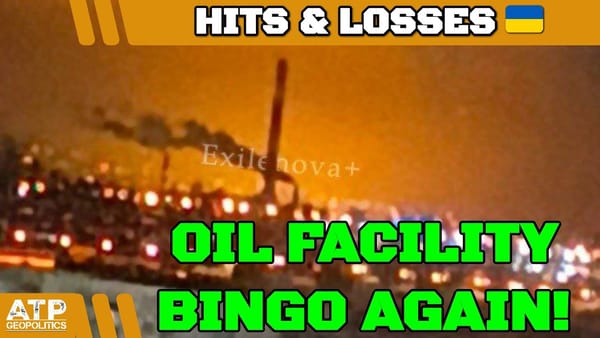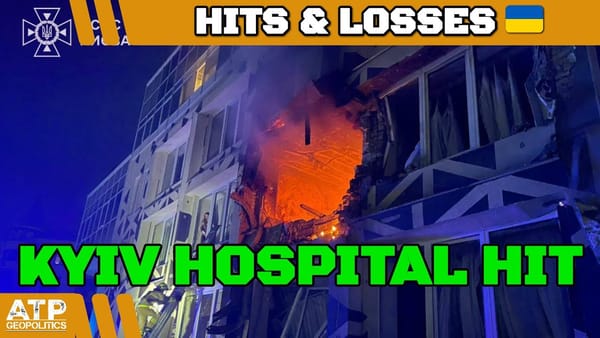Ukraine War Update NEWS: Pt 1 - Overnight & Other News
Table of Contents 📖
"You would if you could, you aren't so you can't."
Hello Team
🎦 00:00-00:11⏩
Jonathan welcomes viewers to another ATP Geopolitics video, a Ukraine War News Update for the 29th of March 2024 - part 1.
Return to top⤴️
🪦 DISCLAIMER FOR GENERAL STAFF LOSSES DATA
- These are real people with real lives and real families who love them. Don’t let the numbers sap your humanity.
- These numbers probably aren’t accurate but they’re the best we have and we don’t need them to be accurate to be indicative of patterns of activity.
- All losses are estimates. Losses cannot be counted with accuracy because of the conditions on the ground.
- Both sides would see it to be of their advantage to minimize their own losses maximize the other side’s losses.
- Neither side releases their losses but we have enough transparency from the Ukrainian side to have confidence in they are indicative.
- Personnel losses are hard to count. If a soldier gets injured, heals up, and returns to the front line only to get injured again, is that one loss or two? Also, how to deal with losses from PMC’s or soldiers fighting with RF from occupied territories?
- Equipment losses are hard to count. If an AA complex involves several parts and one part gets disabled, is that a loss, or a fraction of a loss? If a tank gets disabled, repaired, back into the fight, then disabled again, is that one lost tank or two?
- All recorded losses are vulnerable to multiple reporting. We have already seen numerous cases of multiple drones in the air reporting the same loss from different angles as multiple engagements.
- Losses are not always reported on the same day they occurred. It is frequent that drone losses are reported at least 24 hours after other terrestrial equipment losses. Certain losses may not be reported for days or weeks for military intelligence reasons.
Ukrainian General Staff Report - Russian Losses
🎦 00:11-01:19⏩
Jonathan begins with an update on Russian losses from the previous day, based on figures from the Ukrainian general staff, reminding viewers that each loss represents a human life.
- Personnel: 820
- Tanks: 8
- Armored Personnel Vehicles (APVs): 27
- Artillery systems: 28
- Multiple Launch Rocket Systems (MLRS): 2
- Anti-aircraft warfare systems: 6
- Vehicles and fuel tanks: 50
- Special equipment: 7
Jonathan notes the significant number of anti-aircraft warfare systems lost by the Russians, indicating a possible shift in Ukrainian tactics.
Return to top⤴️
Oryx/Perpetual Losses - 28/03/2024
🎦 01:19-03:15⏩
Jonathan reviews visual confirmation of equipment losses using data from Oryx, curated by researcher Andrew Perpetua. Ukrainian Losses:
- Several tanks
- Numerous M113 APCs
- A variety of trucks and boats.
Russian Losses:
- Communications equipment
- Several recovery vehicles, impacting their ability to recover damaged equipment near the front lines.
- A TOS-1A thermobaric launcher
- A range of tanks, including a T-90M (their most modern tank)
- Various infantry fighting vehicles (BMP-2s, BMP-3s, BRMs, and BTRs).
- APCs, trucks, and civilian vehicles (including Pekankas and "Scooby-Doo" vans).
Jonathan highlights the significant losses incurred by the Ukrainians, particularly in terms of equipment and their ability to maintain mass on the battlefield.
Return to top⤴️
Oryx/Perpetual Losses - 29/03/2024
🎦 03:15-06:00⏩
Jonathan reviews visual confirmation of equipment losses for the 29th March 2024 using data from Oryx. He notes the favourable loss ratio for the day, suggesting it offsets the previous day's losses for Ukraine. Ukrainian Losses:
- A few tanks and BMPs.
- No high-value equipment.
Russian Losses:
- A Su-27 fighter jet lost to friendly fire in Crimea.
- Air defense systems: An Osa (SA-8 Gecko) and potentially more, as there is often a reporting lag.
- A 9S36M fire control radar (part of a Buk-M1 or Buk-M2 system).
- A recovery vehicle.
- A 240mm self-propelled howitzer.
- Several artillery pieces.
- A variety of tanks.
- Infantry fighting vehicles
- APCs, trucks, civilian vehicles, golf carts, quad bikes, and buggies.
Jonathan observes the increasing presence of quad bikes, golf carts, and buggies in Russian losses, speculating on whether their use stems from desperation or tactical advantage. He leans towards the former, viewing these vehicles as unsuitable for frontline engagements and questioning their effectiveness in keeping soldiers safe.
Return to top⤴️
Russian Su-27 Downing - Friendly Fire?
🎦 06:00-08:03⏩
Jonathan revisits the downing of a Russian Su-27 fighter jet (initially misidentified as an Su-35) over Crimea. He highlights the significant financial and functional loss, emphasizing the impact on Russia's operational capabilities. The loss of skilled personnel trained to operate these systems is also noted. Jonathan provides context around the incident, emphasizing the unlikelihood of Ukrainian involvement given the location (Sevastopol) and the presence of Russian air defense systems. He concludes that it was almost certainly a friendly fire incident, particularly as it occurred during air raid alerts in the area.
Return to top⤴️
French AASM HAMMER Guided Bombs
🎦 8:03-09:52⏩
Jonathan discusses the French-supplied AASM HAMMER guided glide bombs being used by Ukraine, noting their effectiveness in targeting Russian positions around Kherson. He commends France for providing 50 bombs per month (with a potential increase in production) while acknowledging the significant disparity in scale compared to Russia's use of their own KAB guided bombs (700 deployed in a week). Jonathan shows imagery of a building, reportedly a drone base HQ, that was targeted by an AASM HAMMER, emphasizing the weapon's destructive power and its potential to shift momentum in favour of Ukraine. He acknowledges the limitation of Ukraine's small air force and limited ordnance compared to Russia's larger aerial capabilities.
Return to top⤴️
Russian Radar and Osa (SA-8) Air Defence System Destroyed
🎦 09:52-11:27⏩
Jonathan reports on the destruction of a Russian radar system, potentially part of a Buk missile system, by a Ukrainian FPV drone. He also notes the destruction of a Russian 9K33 Osa (SA-8 Gecko) air defence system south of Bakhmut, again attributed to a Ukrainian FPV drone. Jonathan emphasizes the crucial role of drones for both sides in the conflict.
Return to top⤴️
Russian 2S40 Floks Self-Propelled Howitzers
🎦 11:27-12:26⏩
Jonathan discusses the Russian 2S40 Floks, a new self-propelled howitzer that entered service in October 2023. He questions the claimed short range of 10 kilometers, suggesting that such a limited range would make the weapon highly vulnerable to Ukrainian counter-battery fire.
Return to top⤴️
Russian Missile and Drone Attacks Overnight
🎦 12:26-23:29⏩
Jonathan shifts focus to overnight missile and drone attacks on Ukraine's energy infrastructure, noting a significant wave of strikes. He references data from a spreadsheet maintained by a contributor named "Dell", showing trends in Russian missile and drone usage:
- Drone Usage: Relatively consistent, with a recent high of 75.
- Cruise Missile Usage: Recent days have seen a higher number of cruise missiles used. However, Jonathan believes Russia is likely struggling to maintain its previous levels of usage, as evidenced by a decline in numbers compared to earlier in the war.
- Ballistic Missile Usage: Jonathan observes an increase in the use of ballistic missiles, which are harder for Ukrainian air defenses to intercept. This suggests a deliberate shift by Russia to exploit this advantage.
Jonathan analyzes Ukrainian interception rates based on data from Ukraine Battle Maps, highlighting successes in shooting down drones and specific types of cruise missiles while acknowledging the challenge posed by ballistic missiles, which Ukraine currently lacks sufficient defenses against. He expresses concerns over potential damage to Ukraine's energy infrastructure in Dnipropetrovsk, Vinnytsia, Ivano-Frankivsk, Lviv, Chukchi, and Chenevetsk regions, noting the widespread impact of the strikes. He cites various sources, including Anton Gerashchenko and Tim White, who are tracking the strikes and their aftermath. Jonathan acknowledges the financial burden of these attacks on Russia, while questioning their effectiveness. He speculates that Russia might be achieving a return on its investment if Ukraine's energy infrastructure is severely crippled. The route of these overnight strikes is discussed, with Jonathan pointing out a particular cruise missile that took an unusual and circuitous route, indicating possible efforts to circumvent Ukrainian air defenses. He also mentions reports of drone debris landing in Romania near the Danube River, adding another layer of complexity to the situation.
Return to top⤴️
Explosions Reported in Saki Air Base - Crimea
🎦 24:53-25:24⏩
Jonathan reports on explosions at the Saki military base in occupied Crimea, interpreting this as a Ukrainian strike. He uses his mantra, "You would if you could, you aren't so you can't," to explain the recent lull in Ukrainian strikes on Russian territory. Jonathan believes that Ukraine likely lacks the necessary numbers of drones and missiles to sustain regular strikes and is either stockpiling or facing limitations in their domestically produced weaponry.
Return to top⤴️
Zelensky CBS Interview Highlights
🎦 25:24-28:08⏩
Jonathan discusses key points from Zelensky's recent interview on CBS, noting it as a must-watch. Key takeaways include:
- Planned Russian Offensive: Zelensky reveals intelligence suggesting Russia is planning a major offensive at the end of May or June.
- Artillery as a Precursor: He interprets intensified Russian artillery attacks as a potential precursor to ground assaults and attempts to occupy Ukrainian territory.
- Need for Increased International Assistance: Zelensky emphasizes the urgent need for more military aid, particularly air defense systems, revealing that 75% of American aid remains undelivered. He highlights the economic benefits to the US of providing this aid, noting that a significant portion of the funds stay within the American economy. He argues that while 80% of the aid money might initially stay in the US, the remaining 20% that goes directly to Ukraine is effectively recouped through subsequent arms sales to other nations replenishing their own stockpiles. Therefore, it could be argued that 100% of the US aid money ultimately benefits the American economy.
- Potential Wider Conflict: Zelensky warns of potential missile strikes on other countries if Ukraine were to be defeated.
- Impact of Drone Attacks on Russian Fuel Production: He highlights the success of Ukrainian drone attacks on Russian refineries, citing a 14% decrease in gasoline production and a 7% decrease in diesel fuel production year-on-year. He attributes this information to Radio Liberty.
Ukraine Striking Inside Russia - A Debate
🎦 28:08-32:14⏩
Jonathan addresses the debate surrounding Ukraine's right to strike targets within Russia, particularly in light of recent statements from US officials that seemed to discourage such actions. He challenges the notion that Ukraine has been forbidden from conducting such strikes, arguing that the US is employing careful rhetoric to avoid escalating tensions with Russia while not explicitly prohibiting Ukraine from acting in its own self-defense. Jonathan analyzes the language used by US State Department Spokesperson Matthew Miller, emphasizing the distinction between "not encouraging" and "discouraging" such strikes. He argues that the US is attempting to remain neutral to appease Russia and avoid a larger conflict. He cites analysis from Jake Brough, who refutes claims that Ukraine has been explicitly forbidden from striking Russian territory. Jonathan also references critical comments from Garry Kasparov, who believes the US is hindering Ukraine's ability to defend itself by imposing such limitations. Jonathan concludes that while the US might prefer Ukraine to refrain from striking targets within Russia using Western-supplied weapons, there's no evidence to suggest a direct prohibition. He believes the US is trying to placate Russia while still allowing Ukraine to use its own domestically produced weapons as it sees fit. This approach, Jonathan suggests, aims to provide Ukraine with a degree of autonomy while managing the risk of escalating the conflict.
Return to top⤴️
Jack Gleeson Visits Ukraine
🎦 32:14-33:32⏩
Jonathan takes a lighter moment to acknowledge the visit of Irish actor Jack Gleeson (known for his role as Joffrey Baratheon in Game of Thrones) to Ukraine. Gleeson participated in delivering a pickup truck donated by British volunteers to the Ukrainian armed forces. Jonathan humorously expresses his struggle to reconcile Gleeson's real-life humanitarian efforts with his notoriously villainous on-screen persona.
Return to top⤴️
Sursky Interview Highlights
🎦 33:32-40:05⏩
Jonathan discusses a recent interview given by General Valerii Zaluzhnyi's successor, General Oleksandr Syrskyi, highlighting key points:
- Russian Losses: Syrskyi reiterates the significant losses suffered by Russian forces in terms of military equipment, attributing the reduction in Russian air activity to the effectiveness of Ukrainian air defense.
- Need for More Air Defense: He echoes Zelensky's call for increased international support, particularly for air defense systems and missiles.
- Personnel Rotation: Syrskyi addresses concerns about potential exhaustion and low morale within the Ukrainian armed forces, stating that they have implemented a rotation system for frontline units to ensure adequate rest and recovery for their soldiers.
- Reduced Personnel Needs: He reveals that, thanks to this rotation system and a recent audit, the Ukrainian military's need for additional personnel has decreased from the previously stated 500,000.
- Avdiivka Withdrawal: Syrskyi defends the decision to withdraw from Avdiivka, attributing it to a lack of sufficient air defense systems and artillery ammunition to counter Russia's aerial bombardment. He believes that maintaining a presence in Avdiivka under such circumstances would have led to unnecessary casualties without achieving strategic objectives.
- Kharkiv Defense: He issues a stern warning to Russia against attempting another offensive on Kharkiv, asserting that the city would prove to be "fatal" for Russian forces.
- Gratitude for Western Support: Syrskyi expresses his gratitude to Western allies for their ongoing military aid, acknowledging its vital role in Ukraine's ability to defend itself.
- Domestic Arms Production: He highlights Ukraine's efforts to boost its domestic arms production, citing the development of the 155mm Bogdan self-propelled howitzer and the establishment of a production line for some components of the M777 howitzer. He emphasizes the goal of reducing reliance on foreign aid and achieving greater self-sufficiency in terms of military equipment.
Jonathan finds Syrskyi's statements revealing, particularly his emphasis on the need for air defense systems and artillery shells, which echoes his own long-held assessment of the situation. He sees Syrskyi's comments about the rotation of troops and the decrease in personnel needs as positive developments, indicating a more strategic and sustainable approach to managing Ukraine's defense.
Return to top⤴️
Wrap Up
🎦 40:05-41:17⏩
Jonathan concludes the video with his usual sign-off and a bit of self-promotion for his book, "The Resurrection: A Critical Examination," particularly relevant given the upcoming Easter holiday. He encourages viewers to engage with the content by liking, subscribing, and sharing the video and thanks them for watching.
Return to top⤴️




